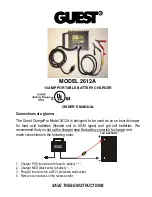
3. Operation in respect to the RES design
In “Stand-alone” systems
, the renewable source – basically PV arrays - is the only charging source available
for the battery. In some systems, an external source - like diesel - can be used but this is not within the basic
design principle, e.g. the source is engaged only intermittently and manually by the user, to serve excessive loads
or to maintain the batteries with equalizing charges.
Two types of charge controllers can be used:
On-Off PV controllers. The controller interrupts the charging current from the PV array (off state) when the
battery voltage reaches the high regulation point (e.g 2.45Vpc) to connect it back (on state) when the voltage
drops to the low regulation point (e.g. 2.35Vpc). This type is not recommended for VRLA batteries.
Constant Voltage type (PWM method is also included here). Once the battery voltage reaches the regulation
point, the controller limits the charging current to keep the voltage constant at this level, given that enough
power is available from the renewable source. Two sub types may be defined here:
o
One voltage step controller: There is only one regulation point.
o
Two voltage step controller: There are two regulation points. Initially the controller maintains an
elevated voltage to recharge the battery fast (absorption stage) then, after certain time or other criteria,
it steps back to a lower voltage to prevent unnecessary overcharging (floating stage)
In “Hybrid” systems
, the renewable source size is smaller than the application load. There is always an
independent source available - diesel or grid – to recharge the battery in every cycle, once a minimum state of
charge has been reached. The same source can be also engaged, either automatically at regular intervals or
manually when required, to maintain the battery with equalizing charges. Only Constant Voltage controllers
(usually with two voltage steps) shall be used here.
3.1. Discharging
No restriction on the discharge current is required, as far as the connections are properly sized and the battery
temperature stays within the allowable limits.
The maximum allowable discharge per cycle (Max Daily DoD - MDDOD) is
20% for Stand-alone and
60% for Hybrid systems
For discharge currents lower than 0.1*C10, the MDDOD is expressed in % of the C10 value. For example, the
c e l l “ RES 6 SOPzV 850” has C10=687Ah therefore a 60% MDDoD means 413 Ah extractable per day.
The maximum allowable DoD (MDOD) is 80% of the maximum available capacity, unless otherwise has been
approved by Systems Sunlight.
Overdischarge Protection
The MDOD limit control should not be implemented solely through control systems based on Ah-counters
(integrating the ampere-hours into and out of the battery). Monitoring the battery voltage against the low-voltage
disconnect setting (LVD) should always be included.
The MDDOD limit control - for hybrid applications - can be realized either by Ah-counters control units or/and by
battery voltage monitoring. For Stand-alone systems see the note below for the Array to Load ratio.
The graphs at the end of this document give the battery voltage to DoD relation as a guidance for the initial LVD
settings (first-try settings). The system designer or installer shall adjust and confirm them upon the actual
conditions of the system. For systems where the voltage is measured at the controller and not on the battery, the
voltage drop on the connections to the battery shall be considered.
For critical systems with the load directly connected on the battery, an alarm or other method of user feedback
must be included to give information on the battery status when DoD exceeds 60 to 80%.
Array to Load ratio for Stand-alone systems
In Stand-alone systems, the renewable source shall be sufficiently oversized against the application load in order
to avoid excessive cycling near the MDOD which limits dramatically the battery’s life expectancy. The ampere hour
output of the PV array (or other renewable source) over the load ampere hours for the minimum design month
(month with minimum PV output) should be at least 1.3 (acc. to IEEE1013) to recharge the battery while the daily
load is supplied.
Low-voltage reconnect (LVR) for Stand-alone systems
The battery voltage at which the load is reconnected after a low-voltage disconnect shall be above 2.2 Vpc


























